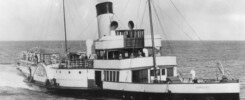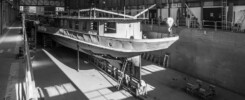
Under the leadership of Capt Stanley Woods, seen here on the bridge of the Princess Elizabeth in 1965, the former Clyde paddle steamer Jeanie Deans was transformed into the Queen of the South in the spring of 1966 for a new career on the Thames.
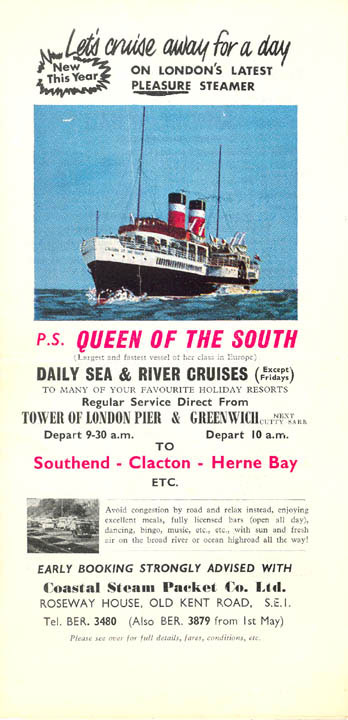
The leaflet for the season, with a reproduction of a painting of Queen of the South by the 13 year old Duncan Nicholson, son of the painter John Nicholson, promised much. Day trips from Tower Pier to Gravesend, Southend and Herne Bay were to run on Mondays, Wednesdays, Saturdays and alternate Sundays and to Gravesend, Southend and Clacton on Tuesdays, Thursdays and alternate Sundays from early June until early September. The publicity offered “Excellent, substantial hot and cold meals (including breakfast) at very reasonable prices are served in the spacious and well appointed restaurant, and here again large windows ensure that passengers see everything of interest – even whilst they are eating! For those requiring light snacks or just a really good cup of tea, the cafeteria on the lower deck is the answer and in the Soda Fountain, soft drinks, ice cream and confectionery of every description will be available. Fresh and succulent Leigh cockles, Margate shrimps and Whitstable whelks will be on sale in the River Room with its fabulous Meletrone which will give passengers the chance to dance in a genuine “Showboat” atmosphere. On Queen of the South we have tried to think of everything for your comfort and pleasure, even if you ask no more than a quiet hour’s rest on the Sun Deck, lying in a specially reserved chair with nothing but the steady, gentle rhythm of the paddle to disturb your peace. Many pleasant hours are sure to be spent by our passengers at the resorts of their choice but we are sure that the time actually spent on board Queen of the South will prove the most memorable part of every trip.” As it turned out, the last sentence was more prescient than the copywriter had intended as there were rather fewer pleasant hours at the resorts and rather more highly memorable hours spent aboard as the Queen of the South staggered from one breakdown to the next.
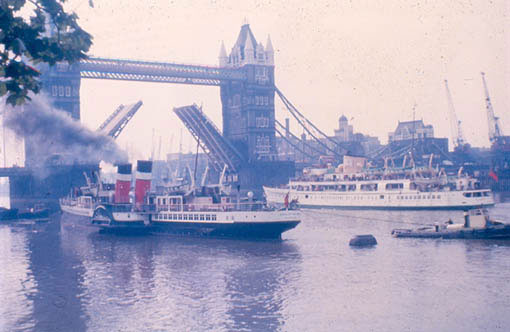
The season started on Saturday 28th May. Unfortunately there was a delay in the ship coming in from the buoys and a further delay whilst stores, doubtless including the Whitstable whelks etc, came aboard. As a result we were very late setting off and Don Rose, the owner, did not look pleased or much mollified by the soothing words coming from the captain.
Capt Woods had made two additions to the wheelhouse, a chart table, an item without which the ship had sailed throughout her Clyde career, and a large brown easy chair which took up a lot of space on the starboard side just forward of the emergency telegraph. Having taken and passed the examination for his Trinity House Pilotage Certificates for the Thames, he reckoned that he would end up spending all day and every day on the bridge so he might as well make himself comfy. As it turned out, though, his pilot’s license for the Thames above Gravesend had yet to be issued so we had to take a pilot for that part of the journey.
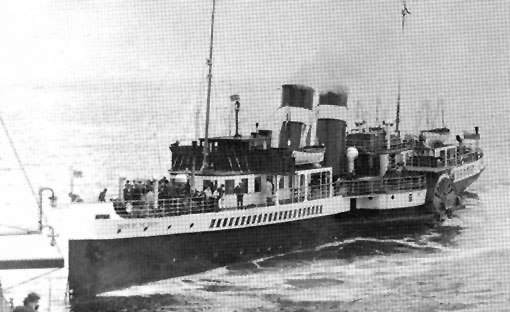
Unfortunately the wicked hobgoblin who seemed to have joined the ship on the Clyde the previous November gave every evidence of still lurking aboard with his wand in even finer form than before as much did not go according to plan. For example, at Southend it was was just about low water. Capt Woods was not sure if the tide had completely bottomed out but thought that it was still ebbing slightly on the pier so planned to come in starboard side to. As it turned out, by the time we got up to the pier, the tide had just started to flood so the berthing went badly awry leaving Queen of the South end on to the pier. At Herne Bay the aft rope was slow to go ashore and the bow fell in resulting in the starboard bridge wing contacting the pier and damaging the starboard light case. Delays crept in everywhere and the ship was very late back at Tower Pier in the evening.
The following day we were off to Clacton but, with low tide again in the early afternoon, there turned out to be insufficient water in the Spitway. I have a very clear recollection of the ship gingerly edging up to the Swin Spitway buoy in the slight swell which was running and Capt Woods saying “she’s bouncing on the bottom” and ringing full astern. That was the closest Queen of the South ever got to Clacton.
On the way back, the mate asked the the pilot who came aboard at Gravesend if he would like a drink possibly expecting an order for tea, coffee or cocoa. “Whisky please” was the response and this was repeated at regular intervals all the way up from Gravesend to Tower Pier. I never saw Capt Woods drink. I did see him looking rather blackly at the pilot during that evening though. And I have sometimes wondered why the whiskies kept coming when the captain so heartily disapproved. Perhaps it was a more polite age and certainly some people at sea did drink then. And when I say drink, I mean consume tremendous quantities of alcohol, sometimes with no very obvious deterioration in their outward appearance or behaviour. Mariners who had been forged in the Second World War and had started drinking on a grand scale to keep at bay the horrors that they had seen and to which they had been subjected, sometimes retained their habits in peacetime.
As we had not got to Clacton and therefore made up time, we were not so late that day and the ship seemed to be running well until the approach to Tower Bridge when an ominous clanking started up in the port paddle wheel. Each night I went ashore to stay with my Auntie Mary in Chiswick so I don’t know if anyone looked at the wheel overnight. But the following morning the noise was still there after we set off and was getting worse. We called at Greenwich but, by Blackwall Point, it was clear that something would have to be done. We stopped and dropped the anchor.
Never a man to lead from behind, Capt Woods was down straight away into the paddle box and, with a saw, started cutting away the offending wooden float. Meanwhile, sensing a touch of salvage, several tugs turned up anxious to offer their services and hovered in hopeful anticipation. Remember that this was a time when VHF port radio was in its infancy and most ships did not have it to summon assistance or keep everyone informed of what was going on. The float came off, was hauled on deck, the anchor was up and we were off, or rather not off, as now, there was a problem with the vacuum pump. So defeat was admitted and Capt Woods negotiated for a tow to Gravesend to unload the happy trippers who were enjoying “a most memorable part of their trip”. With the vacuum pump fixed at Gravesend we then moved under our own steam to the Tilbury Landing stage to await enough water to go into the Tilbury Basin for repairs. And that was the last I saw of the Queen of the South as I was due back in school again the following week.
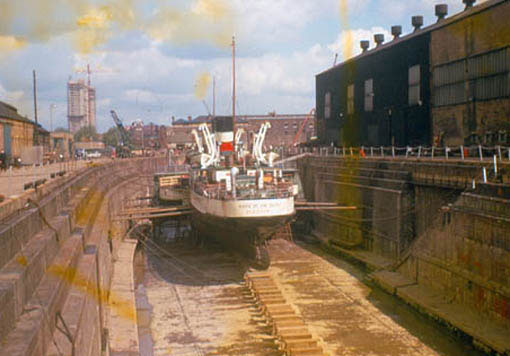
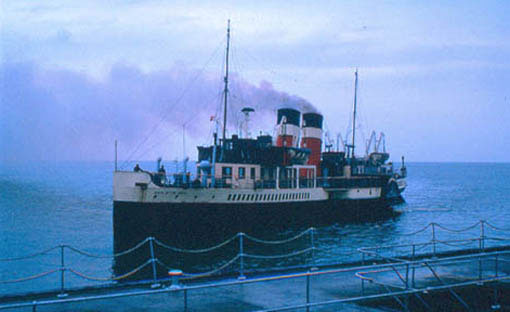
Sailings commenced again on 11th June but lasted only until the following day when further problems caused the cruise to be aborted at Southend on the return after a further spell at anchor. After that the crew were paid off and that seemed to be an end of things. But no – there was to be another go. In July Don Rose started rounding up the crew again but, not surprisingly, people had gone off to do other things. Capt Woods was delivering a coaster. I had written all over the place trying to get myself taken on to some ship somewhere during my school holidays and had just secured a berth aboard the then very modern British Railways Channel Islands ferry Caesarea. So it was with an entirely different crew that Queen of the South set off from Tilbury for London on July 30th to start again.
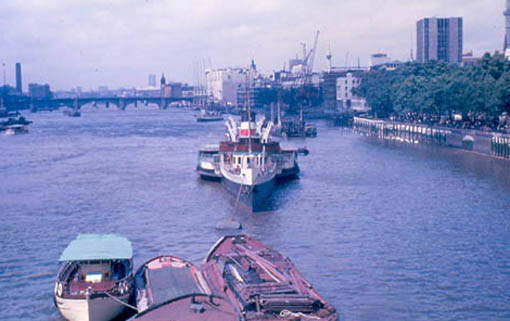
Sadly Queen of the South had no better luck this time, running with only a very few passengers on just two days before breaking down again at Southend on 6th August. She returned to the buoys in the Upper Pool where she remained until August 22nd when she was towed to the Medway to lay up. It had been a summer which started with such high hopes and ended so dismally leaving the ship with a mountain of debts amidst a sea of broken dreams. It was a severe set back for Don Rose.
However he was not a man to give up lightly. 1967 was to see the whole thing, hope and despair, repeated again.
Kingswear Castle returned to service in 2023 after the first part of a major rebuild which is designed to set her up for the next 25 years running on the River Dart. The Paddle Steamer Kingswear Castle Trust is now fund raising for the second phase of the rebuild. You can read more about the rebuilds and how you can help if you can here.
John Megoran

